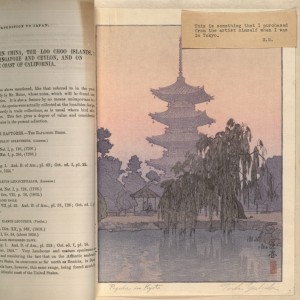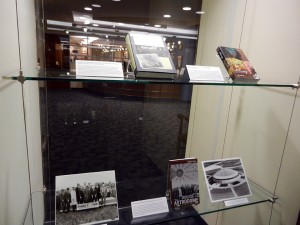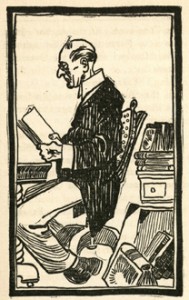
Whether it’s a rare book printing found at long last or piece of ephemera found in an archival collection by chance, those who visit the University of Houston Special Collections almost always find something they cannot wait to share with others. Here we celebrate what makes the University of Houston Special Collections so special–our Favorite Things.
Today Sara Craig, University Archives Student Assistant, offers us one of her favorites.
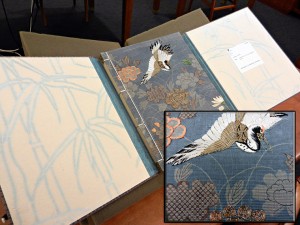
cover of the Narrative of the expedition of an American Squadron to the China Seas and Japan, v.1; inset: detail of embroidery
One of my favorite things in the UH Special Collections is the series of 13 volumes of the Narrative of the expedition of an American Squadron to the China Seas and Japan donated by Maury Maverick, a Texas Congressman in the late 1930s. The Narrative itself was compiled from the journals and notes of Commodore M. C. Perry and his officers during a trip to Asia from 1852 to 1854, first printed commercially in 1856. What makes this particular set so fantastic is the care that went into the binding and creation of each volume. Each individual book is unique, with a soft cover Japanese four-hole stab-bound (Yotsume Toji) book ensconced in a tri-fold hardcover case. These books are considered to be extra-illustrated, that is the creator of the books took the narrative and added in extra pages containing maps, prints, newspapers and other ephemera before rebinding, creating a unique and unusual set of books.
Extra-illustrated books were an unusual fad that was popular in the late 18th to early 19th century in England and the United States. Collectors of extra-illustrated books would pay to have an original printed book taken apart and rebound with added letters, maps, prints and pages from other books. Often the rebound books would be encased in gilt and leather bindings. Occasionally the extra-illustrations in a book refer to sketches, drawings and small paintings included in an original binding of a book.
Some of the extra information added, including the newspapers, deal with the aftermath of World War Two and the signing of the treaty with Japan. There are also items of a personal nature included, a letter from J. Edgar Hoover to Maury Maverick and personal letters from President Truman and his wife, Bess Truman, to Maury Maverick and his wife. Other items appear to be ephemera gathered by Mr. Maverick during his travels in Asia, postcards, Christmas cards and woodblock prints.
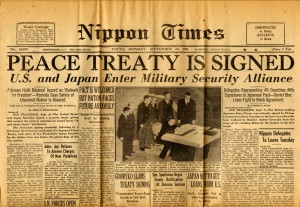
“Peace Treaty is Signed” – cover of the Nippon Times, September 10, 1951, tucked inside volume one of the Narrative of the Expedition…
What first intrigued me about these books, however, was not the information contained within. The visual appeal of the books is obvious. The beautiful book cloth covering each individual volume, each a different pattern, some small and woven, others either created using a wax-resist technique or hand-printed to appear so, is eye-catching as you walk down the aisle in the book stacks. Once you open each volume, the actual bound books are covered in a completely different and unique book cloth that complements the exterior case. Some of the interior book covers have areas of hand-embroidery; others appear to be hand-printed.
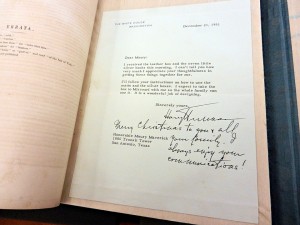
extra-illustrated: as part of the rebinding process, inserted and included is this hand-signed letter from Harry Truman to Maury Maverick (December 21, 1951)
For individuals who are interested in Asian history and culture, both historic and more recent, these volumes are particularly wonderful resources. They are also nice examples of extra-illustrated books, of interest to individuals with an enthusiasm for unusual books or artists books. Even fans of scrapbooking will find looking through this set of books might give them ideas for future projects.
If you have not visited the M.D. Anderson Library recently, you should know that right now we have quite a bit we would like to show you.
Here at the University of Houston Special Collections we continue to shine light on the fruits of research’s labor. Our mini-exhibition, “From Our Collections…” is currently featuring a rotation of three new works that may be viewed at the entrance to Special Collections in the Aristotle J. Economon, Hanneke Faber & Andrew J. Economon Elevator Lobby exhibit space on the second floor. Now highlighting the breadth and variety of research potential contained in our collections are the following:
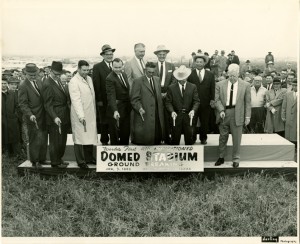
Breaking ground on the “World’s First Air Conditioned Domed Stadium” using Colt .45 pistols in lieu of the more traditional golden shovels (1962, from the George Kirksey Papers), featured on the cover of James Gast’s The Astrodome: Building an American Spectacle.
Incredible Tretchikoff: Life of an Artist and Adventurer, Boris Gorelik (2013); featuring research from the Cruiser Houston Collection.
The Other Great Migration: The Movement of Rural African Americans to Houston, 1900-1941, Bernadette Pruitt (2013); featuring research from the Oral Histories – Houston History Project.
The Astrodome: Building an American Spectacle, James Gast (2014); featuring research from the George Kirksey Papers.
In addition, Pat Bozeman’s exhibit, “1914-2014: Commemorating One Hundred Years — World War I,” continues it’s run at the foot of the Morrie & Rolaine Abramson Grand Staircase on the first floor of the M.D. Anderson Library. Timed in part to commemorate the 100 year anniversary of the armistice, the exhibit features maps, poetry, prose, and propaganda representing a number of the Great War’s belligerent nations.
Also on the first floor you can find the celebrated “Nina Vance and The Alley Theatre: A Life’s Work,” a collaborative curatorial effort carried out by our own Stacey Lavender along with Catherine Essinger, Librarian for UH’s Architecture & Art Library. The exhibit chronicles the people, plays, and places that have made the Alley Theatre what it is today.
Finally, if you have visited us before here on the second floor, you have no doubt experienced our USS Houston permanent exhibition. Pulling letters, photographs, artifacts, and more from our popular Cruiser Houston Collection, the exhibit illustrates the long peacetime and wartime history of a ship that earned the nickname the “Galloping Ghost of the Java Coast” and the sailors who served on her.
But wait, there’s more! Can’t make the trip to campus? I’d be remiss if I failed to mention our growing list of online exhibitions, open 24/7, 365 days a year. A couple of my favorites are UH Homecoming Through the Years, where curators Matt Richardson and Sara Craig draw from our rich University Archives to tell the story of our homecoming traditions, and From American Football to ZZ Top: A History of Robertson Stadium, that highlights the history of the 70 year old stadium that was demolished in 2012 to make way for the new TDECU Stadium.
More information regarding our exhibits, past and present, can be found online here. Hope to see you soon!
This fall semester UH Special Collections hosted Edward Lukasek and Dr. Natalie Houston in a panel discussion, “Life With Books: Collecting, Reading, and Teaching LGBTQI Literature.” If you could not make the event or if you would like to remember that very special conversation, please enjoy the recently published video below courtesy of University of Houston Libraries.
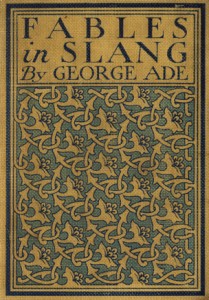 In addition to the over 7,000 linear feet of archival collections made available for study at the University of Houston Special Collections, we are also proud to offer over 100,000 rare and antique books for use in our reading room. Each month we highlight a text from our collections and what makes it so special. This month’s selection is contributed by Library Specialist for Liaison Services and Curator for the new Unique Holdings brown bag lecture series, Kristine Greive.
In addition to the over 7,000 linear feet of archival collections made available for study at the University of Houston Special Collections, we are also proud to offer over 100,000 rare and antique books for use in our reading room. Each month we highlight a text from our collections and what makes it so special. This month’s selection is contributed by Library Specialist for Liaison Services and Curator for the new Unique Holdings brown bag lecture series, Kristine Greive.
George Ade’s Fables in Slang is a collection of satirical fables with titles like “The Fable of the Martyr who Liked the Job” and “The Fable of the Professor who Wanted to be Alone.” Originally published in a Chicago newspaper, these tales mock all the personality types of late nineteenth century America. Even better, the fables are thoroughly illustrated in a bold, exaggerated style, and each ends with a sarcastic moral. In “The Fable of the Man who Didn’t Care for Story-Books,” for example, a man decides that contemporary literature is “all a mockery,” describing all the literature he has read and found lacking. The story concludes with the moral that “Only the more Rugged Mortals should attempt to Keep Up on Current Literature.”
Read a few of Ade’s fables and you’ll join a group of admirers that stretches back over a hundred years. Ade was enormously popular in the early twentieth century; in fact, the advertisement for his other books in the back of Fables in Slang asserts that “Mr. Ade’s books are too well known to require comment here.” He had influential fans, too: Taft held his first presidential campaign rally at Ade’s home, and Theodore Dreiser so admired Ade’s gift for description he even lifted a passage from his fables for use in the original edition of Sister Carrie. In his book on Ade, Lee Coyle locates a passage in the letters of Sir Walter Alexander Raleigh calling Ade “the greatest living American writer, ” an assertion that, while controversial even then, illustrates the name recognition Ade enjoyed in his time. He may not be as well known today, but Ade is forever being rediscovered, with periodic new editions of his works.
Fables in Slang was also recently discussed in The Last Untapped Resource in Houston, the first brown bag lecture in the Unique Holdings series highlighting rare books in our collection. The next event is April 22 and will feature life science books, ranging from centuries old illustrations of mythological animals to contemporary fine press books. In the meantime, why not come to the Special Collections Reading Room and read some fables? Just ask for call number PS1006.A6 F3 1900.
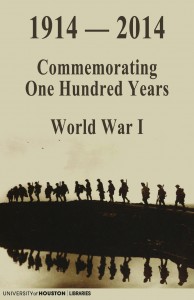
“1914 – 2014: Commemorating One Hundred Years – World War I,” an exhibit from the University of Houston Libraries Special Collections
In remembrance of a dark centennial, those opening days of the Great War, the University of Houston Special Collections is proud to offer “1914-2014: Commemorating One Hundred Years — World War I,” a small exhibition of materials held by Special Collections relating to World War I and curated by our own Pat Bozeman, Head of Special Collections.
On November 11, 1918 Germany and the Allies of World War I met in a rail carriage in Compiègne and agreed to a cease fire to take effect on “the eleventh hour of the eleventh day of the eleventh month,” ending major hostilities of the world’s first, great war. It had begun a little over four years prior, in the summer of 1914, and promised a quick and decisive shift in the fault lines of Europe. Instead, this four year meat grinder would cast a long shadow that rewrote our maps, crumbled our empires, redefined our relationships with one another, and, far from teaching humanity a final and humbling lesson, it ushered in the great and awful maw of man that would be warfare in this new century and our next millennium.
However, for just a brief window beginning that autumn morning in November of 1918, the world was allowed to collectively sigh and reach for rest. Armistice Day, a day celebrating that longing for calm and peace in the aftermath of war, was born.
As you remember those lost and celebrate the peace they helped bring, we invite you to view this exhibit of original materials produced among the storm and in its wake. “1914-2014: Commemorating One Hundred Years — World War I” is available for viewing on the first floor of the M.D. Anderson Library at the foot of the Morrie & Rolaine Abramson Grand Staircase. Highlights include writings from George Bernard Shaw (who saw the wasted lives of youth suffering through the death throes of empires and for capital’s immorality), Rudyard Kipling’s France at War (“They come and fill the trenches and they die… They send more and those die.”), and remarkable examples of WWI propaganda.
If reflections on today have you interested in researching more, remember that in addition to the rare works highlighted above, UH Special Collections is also proud to offer the USS Houston & Military History Collections for study in our Reading Room during normal hours or you can review our Military History Collections via our Digital Library, 24/7, 365 days a year.
